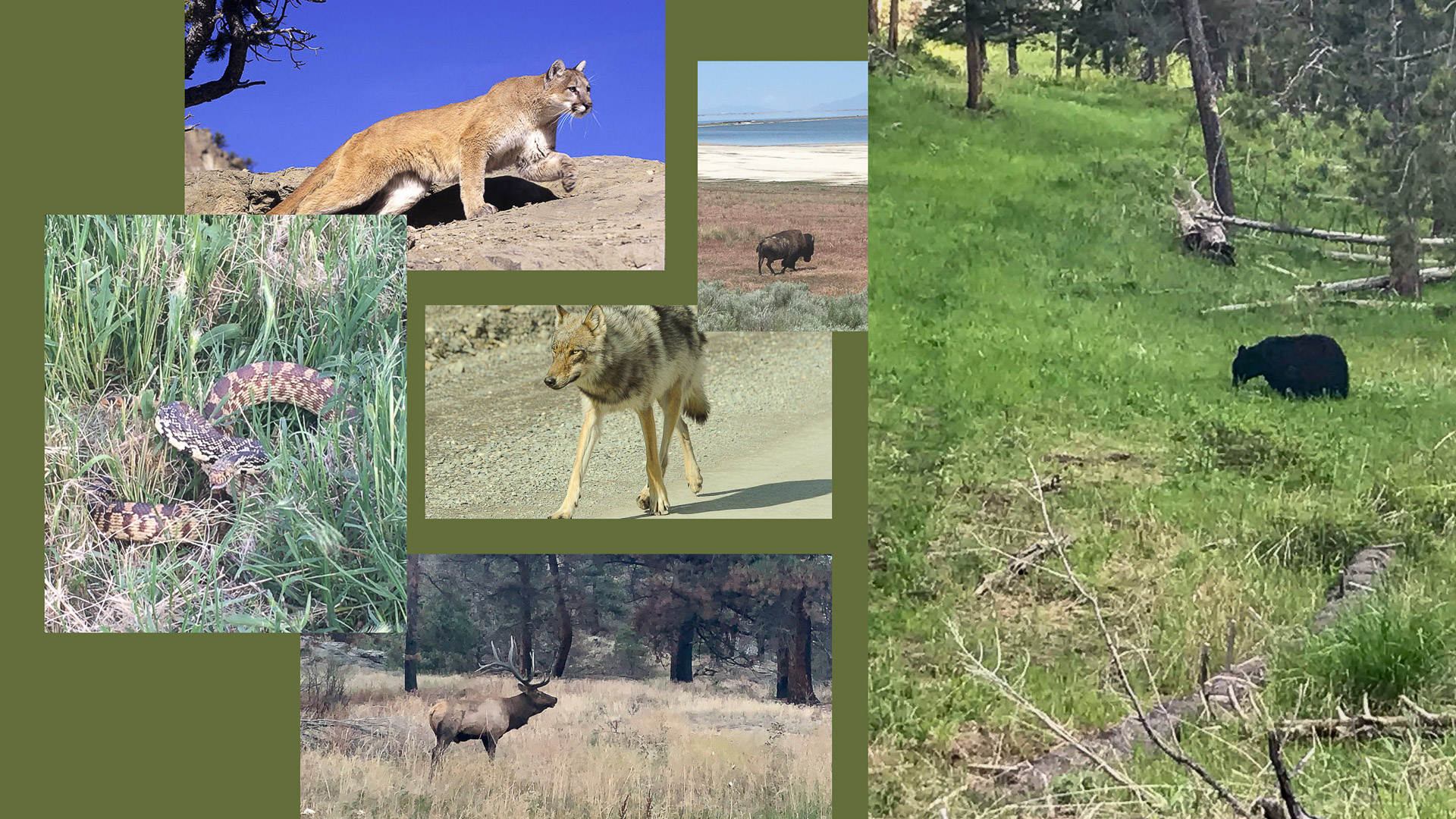
If you spend enough time in the outdoors, it’s more than likely you will encounter an animal or two at the campsite, along the trails or even waterside. It is important to understand what to do when this occurs to be sure that both you and the animal stay safe.
Here are some basic and simple safety tips:
- Stay on the trail.
- Make noise along the trail to alert animals.
- Wear proper clothing.
- Observe wildlife from a safe distance.
- Do not follow or approach wildlife. Never feed them.
- Keep an eye out along the trail.
- Alert others of the presence of animals.
- Carry deterrents, including bear spray, and safety items like a whistle.
- If you have to go off-trail, or need to sit on a log or rock, look carefully before doing so.
Here are more specific tips if you encounter any of these common animals, insects or arachnids while exploring.

Arachnids
Black widows, hobo spiders and recluses are some of the venomous spiders found in the mountains and along trails. If you encounter a spider, or a web, leave the spider alone. Do not poke it or agitate it.
Give the spider space to escape. Leave the web/nest area. If someone is bit, use the RICE method to treat the bite: rest, ice, compress and elevate. Look for symptoms such as swelling, hives and shortness of breath. Seek help from paramedics or a doctor.

Bears
While encounters with bears don’t happen often, bears can be very active around campgrounds and on trails, especially when they are getting ready for the winter. Dusk and dawn are times when bears are most active.
What you should do if you encounter a bear is based on the type of bear. No matter the kind of bear, you should stop and give the animal space to escape. Do not run or turn your back to the bear. If a bear does not move away after seeing you, be sure that you position any children between adults. Or, if you are able, pick up any smaller children. Avoid eye contact, and make yourself look larger. Without turning around, back up slowly.
If you are attacked, how you should act is based on the type of bear. For a black bear, fight back by aiming for their nose. Hit the bear with objects such as rocks or sticks. Keep fighting until the bear moves on. When approached by a grizzly, play dead. Put your hands behind your neck and lie flat on the ground. Make sure your legs are spread to keep the bear from turning you over. Be still until the bear leaves the area. Seek medical attention after it is safe to do so.
Bear spray is also a smart deterrent to carry if you frequently hike in active bear country. Spray if the bear approaches within 30 feet and back away from the area as quickly as possible without running.

Bison
There are plenty of yearly videos of people getting too close to bison in Yellowstone National Park. Trails within places such as Antelope Island and Yellowstone pass through territory where bison roam freely.
If you encounter a bison, do not move toward it. Create 100 yards of space between you and the animal. These animals are very fast relative to their size. Run, climb and/or put something large between you and the bison if it does try to attack. If the bison does make contact, cover vital organs and your head if possible. Medical attention should be sought.

Coyotes/Wolves
If you happen upon a wolf or coyote, the best plan of action is to stop and move away slowly. If you run, they may mistake you for prey trying to get away. If the animal approaches you, make yourself look larger and throw rocks or other objects. Yelling or making lots of noise can also help to scare them off. If you are hurt by a wolf or coyote, seek medical help to treat the wounds.

Elk, Moose, Deer
Deer, elk and moose are typically skittish animals that are more likely to run away than attack. But during rut (mating season), these animals are more territorial and aggressive. If you see any of these animals, do not turn your back. Back away slowly and give them an exit path.
If the animal charges, attacks or begins to signal aggression, place a large object between you and the animal. Climb the object if possible. Running should be a last resort. Curl up and cover your head to protect it from contact. Be still. Wait for the animal to leave the area before seeking first aid.

Mountain Lions
One of the largest predators in the U.S., mountain lions (also known as cougars or panthers) are another animal to be aware of in your surroundings. Mountain lions are most active at dusk and during night when searching for food sources, including deer. They typically attack from behind. If hiking with small children, it is safest to keep them in front.
Stop if you see a mountain lion. Give the animal space to keep on moving. Do not turn your back, and move away slowly. Look large and avoid eye contact. If the lion does not retreat, make loud noises. If attacked, fight back by throwing objects, making noise and protecting your head and neck. Do not give up. Seek aid when the animal has moved along.

Scorpions
If you like to camp, adventure and hike in the desert, you are in the habitat of scorpions.
Stay on the trail. Be on the lookout around debris, tree limbs and rocks. Hike earlier in the day, as they are most active at night. Long clothing can also help provide protection.
As with other animals and insects, give the scorpion space to escape and don’t provoke it. If stung, seek medical help. Keep the person calm and watch for symptoms. Ice may help with any swelling or stinging.

Snakes
The most common venomous snake in the United States is the rattlesnake. Snakes hibernate through the winter. They are most active at dawn and in the early morning, when they look for sun to keep them warm or for shade in the heat of the day. They are also active at dusk, hunting for food.
If you see a snake, leave it alone. Give it space and a means to escape. If you hear it hiss, rattle or make another sound, the snake is announcing it feels threatened. Back away slowly without turning your back. Stomping may help scare the snake away. Do not run.
Keep the victim calm and still if they are bit. Move away from the area of attack. It’s best to keep the bite area below the heart. Remove tight jewelry and clothing from the victim. Get aid and watch for symptoms like rapid breathing and sweating.
Other Encounters
Insects are the most common interaction you will have on the trails. Here are some tips for avoiding bites.
- Wear light-colored and long-sleeved clothing.
- Stay on the trail.
- Use repellent.
- Do not get too close to a nest or disturb it.
- Leave the area if you hear buzzing or if insects circle around you.
- Check for ticks and bites post-adventure.
If biting insects attack, the best defense is to run away. Do not swat. Protect the head, eyes and face. Seek a safe area. Remove jewelry and tight clothing. Look for stingers and try to remove them without squeezing. Treat wounds by washing and apply ice. Administer Benadryl. Seek medical attention quickly.
Remove ticks with tweezers. Aim for the head for removal. Do not squeeze the tick. If possible, save the tick. Watch for symptoms such as rash, hives and swelling. Seek medical aid if needed.





